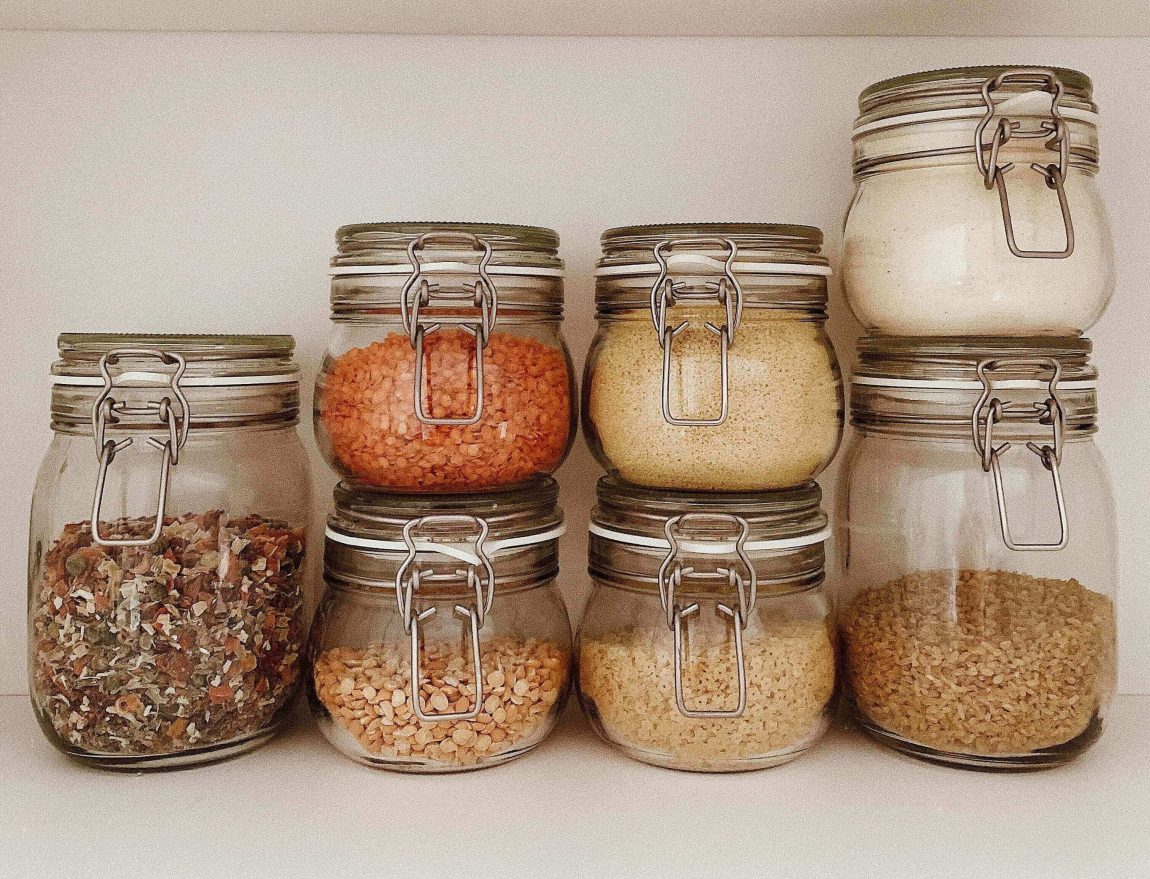Pre-Covid, my pantry was full of impulse buys: lots of snacks, extra can of diced tomatoes (just in case), and bags of sugar I thought I’d use, but didn’t (at least 1 year old).
Post-Covid, my pantry is still full, but it’s a more organized mess, and most importantly, I have what I know I eat, and I have it in extra quantities, in case of emergencies.
If the pandemic showed us something, is that food supply can get low and you might start fighting for bags of rice. Remember the “great battle” of March 2020, where toilet paper was nowhere to be seen and the pasta shelf was empty by 10:00 am? I do, and although I was pretty fast, and got most of my essentials in the days before lockdown, I still regret not buying certain things, like flour, which I couldn’t find for at least a month after.
So, like many other women out there, I started reconsidering my grocery shopping, and most importantly, my pantry organization. If my first trip was pure panic buying, but after a while I realized what I actually needed, so I could make sure I always have stocked cupboards.
So if you are here because a second wave of covid has hit, or if you just need some advice on how to organize and stock a pantry, here are some tips & tricks that helped me tremendously to build a good pantry.
1. Stock the pantry with items that follow two simple rules:
a) they have a long shelf life, and
b) it’s food you actually like to eat.
The second point is actually the most important. Stock your pantry with only what you eat. Sit down and make a list of meals you usually consume: pasta, stews, snacks, etc. Then write down the ingredients, especially the ones that are shelf stable, and add those to your pantry.
In my case, it’s the following products:
- Pasta. It really doesn’t matter the brand or type of pasta, Just go with whatever you prefer and eat. We’ve been on a rice noodle kick recently, so we have at least 3 bags of it at all times.
- Pasta sauce. We go for the simple Italian one. Tomato & basil. At least 3 bottles of it.
- Cans of vegetables. I always make sure I have what I need for a chili, so that means cans of diced tomatoes, black beans and sweet corn. We also stock chickpeas and other types of beans.
- Rice. We use rice for chili, egg fried rice, or for stews. It’s filling and it should definitely have a place in your pantry. I have two kinds: the simple one, and the Uncle Ben’s flavored one. Depends on the food. If it’s a side for meat, we can use the already flavored one. If it’s for chili, we use the simple one.
- Flour. This was a surprise for me during the pandemic. In the first few weeks, flour was one of the first things to go off the shelves, and it took me about 3-4 runs to the supermarket (so 3-4 weeks, since I went once a week) to find it. If you’re a baker or like to make bread, I strongly recommend you get a couple extra bags next time you go to the store.
- Spices. In my case, salt, pepper, garlic powder, cumin and paprika.
- Cooking Oil. Olive oil, avocado oil, coconut oil, whatever you want.
- Milk. I use it for my coffee, and my boyfriend uses it for his cereal or when eating sandwiches. So I always have to make sure we have milk on hand. I usually get the one that is shelf stable, not the one you put in the refrigerator. Yes, I know, it’s not the healthiest option, but I want to avoid going to the supermarket often, and we are pretty inconsistent with our milk consumption, so this helps.
- Snacks. I definitely have a sweet tooth, so I have to have sweets in our pantry. That means cookies, chocolate, but also trail mixes, like dried apricots and plums and caju. I also count cereal, Nutella, peanut butter and jam as snacks/sweets, so definitely make sure you have those, too.
- Paper towels. This one is pretty explanatory. I use paper towels all the time, unfortunately for the environment, so I need to have backups.
- Multi-surface wipes. I don’t know if it counts as a pantry essential, but ever since covid hit and EVERYTHING had to be sanitized, I started building my stock of wipes, as well.
Other items I don’t personally stock, but you can, if you eat it:
- Tuna.
- Spam (or other meat cans).
- Ramen noodles.
- Lentils.
- Oats.
- Baking mixes (pancake, cupcake, etc.)
- Instant Mashed Potatoes
2. Don’t panic buy; build it over time.
This might be a side-effect from covid days, but those weeks of panic buying everything definitely traumatized some of us. That is why it is important to stock a pantry over time, not in one go.
One, to avoid buying everything off the shelves and depriving others of goods, when it’s not necessary.
Two, to figure out, over time (weeks or months), what you actually eat and want in your pantry, so you don’t buy 10 cans of spam you won’t eat.
Three, to stock things you are low on or ran out of, not things you already have 10 of in the pantry.
Be smart about stocking your pantry, and most importantly, about your money.
3. Store the Smart Way: the oldest products in the front.
This is a cool tip I learned from one of my favorite YouTubers: put the products with the most recent expiration dates in the front, so it gets used faster, and you don’t get to it too late.
Similarly, when you go buy another can of diced tomatoes, put it in the back, since it most probably has the best expiration date.
4. Store products by type.
And by type, I mean however you want, it just needs to follow a set of rules, so that it’s easier for you to find. You can store products by grains, cans, containers, bags, etc. Or you could do it by size, if you have issues with that- the bigger ones on the lower shelves, the smaller ones on top.
Or you could do it like I do it, which is by type of meal.
- Up top, I have cans, rice, pasta.
- A shelf lower, I have Milk & Baking.
- One down, and you get to Snacks and Miscellaneous.
- Further down, you have paper towels and wipes.
- And then I go to my utensils and pots & pans.
BONUS
5. Stock your….freezer.
I think I’m cheating here, but let’s just go and assume the freezer area is part of your pantry, since it can store products with long shelf life.
This is also a very important part of having a stocked pantry, in case of emergencies or income problems. The reason why I am talking about it is because it can store meat (a great source of protein) and vegetables (vital for healthy meals).
Now, the refrigerated space is different from household to household. Right now, in my apartment, I have very limited space (3 small freezer shelves), but I know there are people who have an extra fridge in the garage, so that’s great.
Adapt the list below to your needs and your available space:
- Meat. Plenty to choose from (poultry, beef, fish, etc). I do chicken and pork, and ground beef for chili. I also have meatballs and sometimes, chicken nuggets.
- Fries. I just grab the first bag of frozen fries I see in the cool section of the supermarket.
- Cheese nuggets. My boyfriend is obsessed, so I always make sure to have some in the freezer.
- Ice cream. Vital if you have a sweet tooth, like us. Brownie Chocolate for me, Mango Raspberry for my boyfriend.
- Frozen fruit. For smoothies, pies and so on.
So there it is. My tips & tricks for how to stock a pantry. I hope it was useful, that you added at least one new item to the list, and that you’re implementing some of my tricks, I think they can definitely help you.
I love to see what others stock in their pantries (I’ve watched so many YouTube videos lately).
What is in your pantry? What do you stock?
p.s. If you’re on the lookout for new recipes, here’s my Easy Homemade Chili Recipe!






1 Comment
How To Lose Weight: I lost 22 lbs in 2 months | Cozy Home Hacks
January 12, 2021 at 7:14 am[…] If you’re having trouble eliminating temptations from your home, try re-organizing your pantry and stocking it the right […]